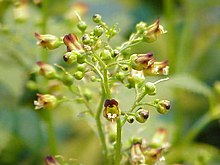The genus Scrophularia of the family Scrophulariaceae comprises about 200 species of herbaceous flowering plants commonly known as figworts. Species of Scrophularia all share square stems, opposite leaves and open two-lipped flowers forming clusters at the end of their stems. The genus is found throughout the Northern Hemisphere.
This article needs additional citations for verification. (July 2012) |
| Scrophularia | |
|---|---|
 | |
| Scrophularia nodosa | |
| Scientific classification | |
| Kingdom: | Plantae |
| Clade: | Tracheophytes |
| Clade: | Angiosperms |
| Clade: | Eudicots |
| Clade: | Asterids |
| Order: | Lamiales |
| Family: | Scrophulariaceae |
| Tribe: | Scrophularieae |
| Genus: | Scrophularia L. |
| Species | |
|
289, see List | |
| Synonyms | |
|
List
| |
Scrophularia species are used as food plants by the larvae of some Lepidoptera species including Phymatopus hectoides.[citation needed]
Some species in this genus are known to contain potentially useful substances, such as iridoids, and several Scrophularia species, such as the Ningpo figwort (S. ningpoensis), have been used by herbal medicine practitioners around the world. The name Scrophularia comes from scrofula, a form of tuberculosis, because several species have been used in herbal medicine for this disease.[1][2]
Selected species


|
References
Wikiwand in your browser!
Seamless Wikipedia browsing. On steroids.
Every time you click a link to Wikipedia, Wiktionary or Wikiquote in your browser's search results, it will show the modern Wikiwand interface.
Wikiwand extension is a five stars, simple, with minimum permission required to keep your browsing private, safe and transparent.
